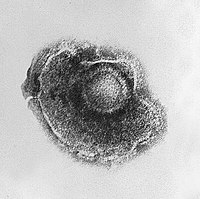
Photo from wikipedia
Dear Sirs, Of previously infected patients with varicella zoster virus (VZV) 20–30% develops shingles and postherpetic neuralgia. Cancer itself and immunodeficiency are risk factors for VZV infection causing neurologic complications… Click to show full abstract
Dear Sirs, Of previously infected patients with varicella zoster virus (VZV) 20–30% develops shingles and postherpetic neuralgia. Cancer itself and immunodeficiency are risk factors for VZV infection causing neurologic complications [1–4]. VZV-encephalitis (VZV-e) is less common in immunocompetent patients and patients with solid tumors, and can present atypically [5–8]. A 60-year-old woman presented with high fever three days after a first course of docetaxel in the adjuvant setting of bilateral breast cancer (left: pT1cN1Mx, right: T2N0Mx). She had undergone a sentinel node procedure and axillary node gland dissection of both mammae, followed by three uncomplicated courses of fluorouracil/ epirubicin/cyclofosfamide (FEC) and the first of three courses of docetaxel (in standard dose for breast cancer: 100 mg/m). Corticosteroids were administered the day before, of, and after docetaxel. Further, the patient had used tamoxifen for two and a half years, and two and a half years she used anastrozole (both tumors were estrogen and progesterone receptor positive; Her2Neu status was negative). HIV serostatus was not determined, but she had not been immunocompromised. She had symptoms of a respiratory tract infection; physical examination and laboratory measures (Table 1) did not reveal any abnormalities and she was treated with cefuroxime according to the protocol for neutropenic fever. After a few days the fever improved, but she developed headache, dizziness, nausea, ataxia, followed by bradyfrenia, pupil asymmetry (7-/5?) and a peripheral left-sided facial nerve palsy. Neutrophils had dropped only slightly (see Table 1). Magnetic resonance imaging (MRI) with gadolinium 55 showed subcortical lesions in the superior temporal gyrus left and insula on both sides (Fig. 1a). Investigation of cerebrospinal fluid (CSF) was abnormal (see Table 1) and PCR was positive for VZV and negative for malignant cells. Aciclovir treatment (3d10 mg/kg) was started with the diagnosis varicella zoster encephalitis. Under treatment, she developed a pupil asymmetry and binocular diplopia, tingling of the side of the mouth and left-sided deafness. Re-examination of the CSF showed an increase in inflammatory cells (see Table 1). MR imaging showed a new lesion in the right-sided basal ganglia (Fig. 1b). After seven weeks of intravenous treatment, PCR did not reveal any copies of VZV and she improved slowly, still suffering from neurologic complaints. In our patient, neurologic symptoms and fever occurred following chemotherapy. Neurologic complications of VZV are mainly described in severe immunosuppressed patients, such as during treatment of non-solid malignancies [9–11]. However, two retrospective case series show CNS infections by VZV in patients of whom not even half was immunosuppressed [9, 12]. Although our patient was not neutropenic during or before the infection, she was treated for active malignancy. & J. M. Zuetenhorst [email protected]
Journal Title: Journal of Neurology
Year Published: 2017
Link to full text (if available)
Share on Social Media: Sign Up to like & get
recommendations!